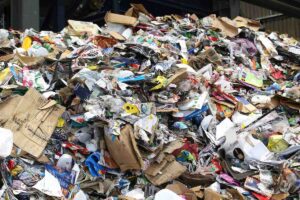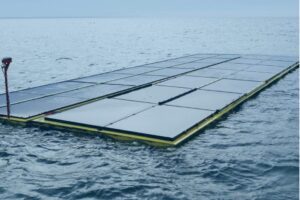Two leading energy academics from the Australian National University have predicted that Australia’s overall greenhouse gas emissions will fall over the next few years, driven by surging investment in renewable energy projects, in an analysis that has been widely panned by senior figures in the clean energy sector.
Professor Andrew Blakers and Dr Matthew Stocks have made the prediction in a new analysis published by the university, that is likely to be leapt upon by the Morrison Government as proof that its policies are working. But the analysis simply reinforces how much more could and must be done given the technologies at hand.
“This is a message of hope for reducing our emissions at low cost,” professor Blakers said.
“Solar and wind energy offers the cheapest way to make deep cuts in emissions because of their low and continually falling cost.”

Under the Coalition government, Australia’s overall greenhouse gas emissions have been increasing since it canned the carbon price, despite substantial falls in emissions from the electricity sector driven by renewables.
The problem is that the greenhouse gas emissions reductions driven by the record investment in renewable energy projects has been more than offset by growth in emissions from the expansion in liquified natural gas for the export market.
But the ANU researchers expect that this trend may reverse, with the current rate of renewable energy development enough to reduce emissions by 10 million tonnes per year, while growth in emissions from LNG projection expected to slow to 3 million tonnes per year. The 7 million tonne gap represents around 1.7 per cent of Australia’s overall emissions and would be sufficient to see them fall.
The prediction is predicated on investment in renewables maintaining its current pace, itself a brave assumption with expectations that investment will slow, as the federal government does not have a renewable energy target beyond 2020.
The ANU analysis has been criticised by many within the clean energy sector including researchers from the Climate Council, who labelled the assumptions used by the ANU academics as “magical thinking”.
“Suggestions that our emissions are set to come down are based on magical thinking and fanciful assumptions. They rely on faith in a government that has done nothing but dampen the spirits of the renewable energy sector,” the Climate Council’s senior researcher Tim Baxter said.
“If the Federal Government actually had a climate policy we could rapidly decarbonise and make great strides. However, in the absence of Federal direction the market will struggle to continue the uptake of renewables.”
Labor climate spokesperson Mark Butler added to the criticism by pointing to comments from Clean Energy Council chief exectutive Kane Thornton who labelled the analysis “ignorant and misleading.”
“Analysis by Professor Andrew Blakers on renewables and emissions projections doesn’t reflect what’s really happening in the renewable energy industry,” Butler said. “Far from the scenario imagined by Professor Blakers, the reality confronting this industry is one of collapsing investment and the loss of thousands of jobs.”
“The reality is that emissions will continue to rise under a Government that has no climate change plan – their own data show emissions have been rising ever since 2014 and will continue rising all the way to 2030.”
The analysis produced by Blakers and Stocks predicts that Australia’s emissions would fall by 3 to 4 per cent by 2021, as long as record-high investment in large-scale renewables projects continues.
“We are just starting to see large drops in electricity emissions from the recent increases in wind and solar deployment, with more to come from wind and solar currently being built,” Dr Stocks said.
“Government policy that is more stable and supportive of renewable energy than at present would encourage continued or accelerated deployment of solar and wind energy.”
Blakers and Stocks believe this represents a positive opportunity for the government, raising the possibility that the 2030 Paris targets could be achieved without the need to rely on the carryover of surplus Kyoto units, provided renewable investment is maintained at its current level.
“If current renewable energy deployment rates stay constant then electricity emissions in 2030 will be about 60 MT and Australia will be able to meet its Paris emissions target without using past Kyoto accounting credits. The net cost would be low or zero because of low and continually falling prices for solar PV and wind,” the paper said.
The analysis found that for Australia’s emissions to fall further over the next decade, the federal government must put in place policies to support further uptake of renewables.
“Federal and state governments can ensure that emissions continue to fall on the back of renewable energy by enabling adequate electricity transmission and energy storage,” Blakers added.
“Declining emissions throughout the 2020s depends upon Government, particularly the Federal Government, to facilitate construction of adequate electricity transmission and storage to allow continued rapid deployment of solar and wind. Without this, emissions may rise again,” the paper said.
Blakers said that while positive progress was being made towards reducing emissions in the energy sector, it was crucial that the government also supported additional investment in enabling infrastructure, such as like transmission networks that link renewables to the rest of the National Electricity Market.
“If the renewable energy pipeline is stopped or slowed down because of insufficient transmission and storage, then emissions may rise again from 2022,” Blakers said.
An expansion of the undersea transmission capacity between Tasmania and mainland Australia would also significantly boost access to pumped hydro energy storage, Blakers said, and was another example of the type of investment that would boost the reliability of the electricity system, while facilitating further uptake of renewables.
“The extra cable would also reduce the effect on Tasmania of occasional outages of the single existing undersea transmission cable,” Blakers said.
Blakers leads the group within the university’s college of engineering and computer science, which has previously produced a comprehensive assessment of Australia’s pumped hydro energy storage potential.











